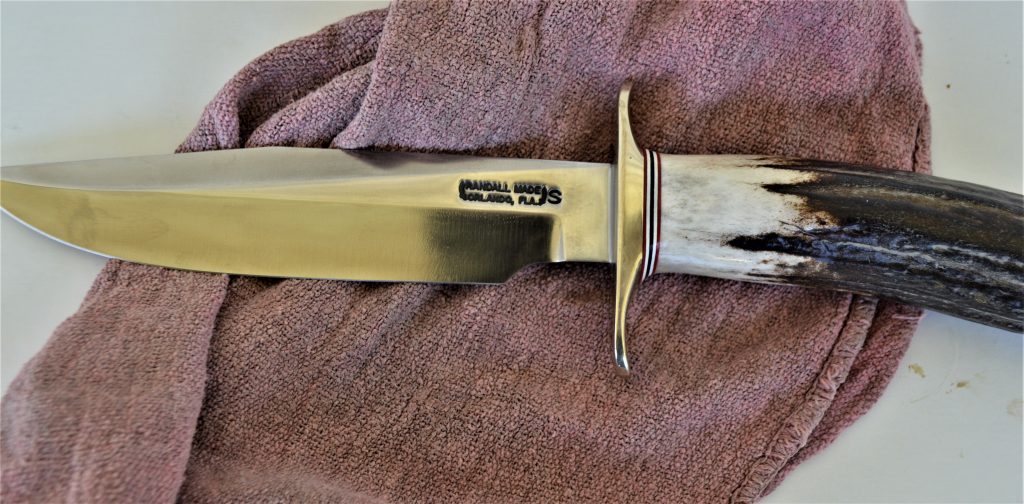
A knife is our oldest tool. A fixed blade knife is most rugged, and when we pick a knife for rugged chores such as camping, cutting food, and opening packages a fixed blade is best. Introducing a mechanism into the edge tool makes things complicated. A spring was used in some folding knives. All folding knives have some type of bearing surface. A back lock, mid lock, liner lock or other type of lock is used. Knives are assembled with rivets screws and dovetailed fit. Modern knives are designed for easy maintenance, disassembly, and tightening when needed. If cared for they will last generations. That is the key. Lets look at some of the best ways to maintain the edged tool.
A failure would be a serious calamity when you really need a knife far from home. A flea market knife used for opening boxes and cutting tape is easily discarded and replaced. I engage in periodic maintenance of all my better class of knives. If a blade edge is neglected it is difficult to restore. Once corrosion sets in a blade may pit. Stainless is just that stain-less not stain proof. Keep the edge clean and wipe away bits of material from cutting chores. Keep a light coat of oil on the knife during storage. Tighten the folder’s handles or scales and keep the pivot points lubricated. But don’t lubricate the lock!




There are many methods and tools for sharpening. I use the Work Sharp guided field sharpener. As a result my sharpening skills are much better. While my uncle Heyward was a master of the stone I am not. My knives are just as sharp as his. A caution- you would never wax your vehicle without first cleaning. By the same token never sharpen a blade without first carefully cleaning. Otherwise you are simply rubbing material into the blade and perhaps gouging the steel. Sharpening restores a dull or even damaged edge. Knives make poor crowbars. A broken point may be reshaped but best not to break it in the first place. Sharpening removes a bit of metal from the blade producing a bevel. The Work Sharp sharpening tool offers a 20 degree sharpening surface and a 25 degree honing surface. Manual sharpening should be a few steps removed from the stone but I seldom use an electric sharpener. You may be surprised how seldom a knife needs sharpening. A home steak knife or kitchen tool may be sharpened perhaps twice a year, a camp knife after a camping trip and some use. Honing is maintaining the edge and is a less difficult process used more often. I would not like to count the times some of my camp knives have been sharpened. They are still useful but blade geometry eventually changes. When a blade has been neglected clean first then begin sharpening with the coarsest surface and proceed to the finest surface. The Work Sharp device features a fine and coarse diamond plate, ceramic rod and a leather strop. This will fit all types of sharpening styles. More injuries are the result of a dull knife stubbing and stopping short causing the hand to run forward on the blade than are caused by a sharp knife!


In survival gear I have no room for nostalgia deploying the most modern proven gear. Just the same a hobby is collecting used quality folders from flea markets and yard sales. Some such as the Solingen folder were good finds. Be wary, however, as there are Pakistani and Chinese copies that look real but the metal quality isn’t good. It isn’t a pursuit I recommend unless you have good steel to rely on and use the chaff for a hobby. That said I have learned a great deal about knife maintenance cleaning and restoration. Folding knives much be serviced occasionally whether you use them or not. This means the pocket folder you rely for defense or emergency must be cleaned. Debris in the mechanism could impede folding. It is possible a tangle of thread could prevent the knife from opening. This is why I recommend a robust design such as the CRKT M16 as a folder. As a camp knife a fixed blade is the best choice. As I was writing I opened my CRKT M16 and checked the un-sharpened blade surface. Sure enough there was plenty of grainy grit present.

The folding knife much open close and lock correctly. A simple wipe down occasionally is recommended. Some use gun cleaner of the penetrating aerosol type, a friend uses a computer air duster. At some point you may need to partially disassemble the knife. Most knives have hex screws that allow disassembly. Search for grit and debris that may affect function. Since the lock works by friction don’t lubricated the lock mating surfaces. Pivot pins should be lubricated. Detritus affects function. Usually the scales don’t pick up much debris but it is a good idea to wipe them down and remove accumulated dust. This is all that is needed in the normal course of use. Depending on how much you use the knife torx screws eventually work loose. These should be tightened. I check my primary carry knives every month or so. Most of these knives use Torx screws either #6 or #8 so tools are not difficult to locate. This is simple enough hardware store gear. Take care of the edged tool and our oldest tool will serve well with little attention.



